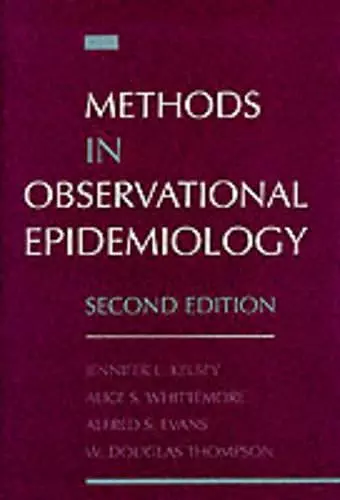Methods in Observational Epidemiology
Alfred S Evans author Jennifer L Kelsey author Alice S Whittemore author W Douglas Thompson author
Format:Hardback
Publisher:Oxford University Press Inc
Published:8th Aug '96
Currently unavailable, and unfortunately no date known when it will be back

Providing a comprehensive picture of the design, conduct, analysis, and interpretation of non-experimental studies of both infectious and non-infectious diseases, the Second Edition of this widely used text has been thoroughly updated to take into account the numerous developments in epidemiology over the past decade. Since the first edition was published in 1986, additional sources of data have become available through the increasing use of computerized records for health-related purposes. Also, a better understanding of the uses and limitations of certain epidemiologic concepts has been gained. Modifications of traditional study designs, including nested case-control studies and case-cohort studies, are now more frequently employed. Biological markers of exposure, disease susceptibility, and disease itself are used in many studies and methods of statistical analysis have been further developed. All of these developments have been considered in writing the Second Edition. The authors cover the full scope of observational studies, describing in detail cohort studies, case-control studies, cross-sectional studies, and epidemic investigation. The use of statistical procedures is described in easy-to-understand terms. Sample size estimation, sampling, measurement, and measurement error are fully discussed. Each chapter in the second edition has been updated and several chapters have been expanded. Chapter 3, which summarizes sources of data on disease occurrence, includes several additional sources of data. Chapter 5, which describes modifications of traditional study designs, now contains nested case-control and case-cohort studies. Chapter 15, on other types of measurement, has been expanded to include sections on measurement in epidemiologic studies of the elderly and on biological markers since these have become major areas of epidemiologic research in recent years. Much of the material in Chapters 6, 7, and 9 on the analysis of data from epidemiologic studies is also new to this edition. Perhaps the greatest challenge for the authors in writing this Second Edition was to make some of the modern, frequently used methods of statistical analysis understandable to readers with a limited mathematical or statistical background. Although this book is intended for readers who have had introductory courses in epidemiology and biostatistics, even readers who do not fully comprehend the theory behind some of the techniques should understand the rationale for their use and be able to interpret results when they appear on a computer printout or in the literature. The Second Edition of this widely used text will serve as a practical resource for students and practitioners of epidemiology, public health and biostatistics.
From reviews of the first editon: "A much-needed, descriptive, informative, comprehensive, and up-to-date guide to the many theoretical facts as well as the important practical applications of observational epidemiology. [The authors] expand on many concepts their colleagues merely label and focus these topics as the essence of epidemiological issues.... The book is excellently illustrated with appropriate tables and figures that aid in the lucid presentation and clarification of the concepts and examples covered.... Should serve as an excellent text for students learning methodology in epidemiology and as a handy and reliable reference source for scientists and researchers actively involved in non-experimental epidemiologic investigations." --The Yale Journal of Biology and Medicine
"The most impressive feature...is its clarity....Throughout the book principles are illustrated by well-chosen examples from studies on a wide diversity of diseases." --The Lancet
"A comprehensive methods book covering a broad range of topics.... Important and complicated concepts are communicated in a readable format with a minimum of symbols and equations, making this text appropriate to a wide audience within the field of public health.... Well written...I highly recommend this book both as a graduate level text, and as a basic reference for practicing professionals." --The Epidemiology Monitor
"The authors can be commended for their successful efforts in compiling a much-needed, descriptive, informative, comprehensive, and up-to-dtae guide to the many theoretical facets as well as the important practical applications of observational epidemiology. They expand on difficult concepts that their colleagues merely label and focus these topics as the essence of epidemiological issues.... The book is excellently illustrated with appropriate tables and figures that aid in the lucid presentation and clarification of the concepts and examples covered.... Should serve as an excellent text for students learning methodology in epidemiology and as a handy and reliable reference source for scientists and researchers actively involved in non-experimental epidemiologic investigations." --The Yale Journal of Biology and Medicine
ISBN: 9780195083774
Dimensions: 239mm x 166mm x 32mm
Weight: 753g
448 pages
2nd Revised edition